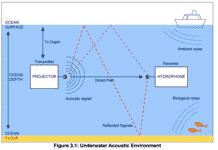Medium Access Control Protocols for Underwater Acoustic Networks
Acoustic communication is commonly used underwater, since radio waves suffer from severe attenuation through water. The propagation environment is challenging and characterised by highly variable spatial and temporal conditions due to multi-path propagation and Doppler effects amongst other factors. The propagation delays are both long and variable if transmitting nodes are located at different distances from a receiver. These unique conditions make the design of medium access control protocols particularly challenging and very little has been done in this area. This project will explore the issues surrounding the use of existing protocols in representative scenarios, based on simplified propagation models. New approaches will be developed which are capable of adapting to the time-varying conditions in order to provide high throughput capability and controlled delay.
Riverbed Modeler is a network protocol design and simulation tool, which has been used in this project to create a model of underwater acoustic channel. A number of its pipeline stages have been modified to reflect several underwater propagation mechanisms.
The nature of deployment, topology and application play a vital role in shaping underwater MAC protocol performance. It has been found that most traditional protocols suffer in performance from the long propagation delay and the limited bandwidth of the underwater channel. The design of an effective underwater MAC protocol should in particular deal with the bandwidth utilisation versus end-to-end delay trade-off. Given that satellite networks suffer in performance from long propagation delay, adaptation of established satellite schemes to the underwater scenario provides some interesting possibilities. Combined free/demand-assignment multiple-access (CFDAMA) is of particular interest.

Members
- Wael Gorma
- Paul Mitchell
Dates
- June 2015 to
May 2018
Research
